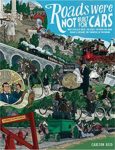By Lou Melini
I first heard about Roads Were Not Built for Cars earlier this year when I was able to attend a small presentation by the author, Carlton Reid. Once Mr. Reid speaks, you will instantly recognize that he is a resident of England. He has spent a lot of time in the United States, and if I recall correctly, he lived here for a short time. His knowledge of both countries is evident in the book as you will be transported to England in many sections of the book. Mr. Reid states that 4 years of research went into the book.
Reading Roads Were Not Built for Cars, one has to remember that it is primarily a history book. It is a history of the cycling culture that then simultaneously describes the evolution to early automobile usage. The time period is primarily from the late 1800’s to 1920 with some content discussing the history before and after. As a cyclist, you will think that the book seems to be more about the early pioneering days of the motor car than cycling history, but that is the point of the book, how motoring evolved from cycling and how cycling led the way to our automobile dominant transit system. It is not a book that you can pick up and breeze through in a weekend, as the writing style simply will not let you do that. The 10” X 8 “, 305-page book is crammed with detail. The bibliography and footnote references are not contained in the book for reasons of space saving in the book according to Mr. Reid. For that fact checking, you need to go online.
Mr. Reid examines the subjects of vehicle speed, road width and “who owns the road” generously giving each topic an entire chapter. It was interesting to read that many of the topics being discussed in 2015, were being discussed over 100 years ago; “While bicycle-only paths were the fervent desire of many cyclists this desire was not shared by all. The building of bicycle-specific routes became a divisive issue for the cyclists of the day (1890’s). There were arguments over whether or not the provision of paths diverted attention from the need to improve roads for all users.”
There were also public policy discussions over road funding. Cyclists in the 1800’s wanted federal funding for roads. However as the book pointed out; “Almost from the founding of the United States, there had been a lack of clarity over the subject of highway construction and maintenance, and whether roads should be paid for by the federal government, the states, counties, towns or individuals. Government, it was felt, must be kept small and limited, or it would become dangerous to liberty and to the people’s welfare. In the 19th century the majority of local and national legislators felt transport was the responsibility only of counties and towns.’
Mr. Reid inserts many court cases in his book. For example in a 1933 court case a judge ruled; “No member of the public has an exclusive right to use the highway. He has merely a right to use it subject to the reasonable use of others…The law….recognizes that there are competing public interests. The law relating to the user of highways is in truth the law of give and take. Those who use them must in doing so have reasonable regard to the convenience and comfort of others and must not themselves expect a degree of convenience only obtainable by disregarding that of other people. “ In 1887 the “Liberty Bill” legislation passed that, for the first time, gave cyclists explicit right to be in the parks of New York City and on the roads. In 1895 the Kansas Supreme court ruled, “Each citizen has the absolute right to choose for himself the mode of conveyance he desires whether it be by wagon or carriage, by horse, motor or electric car, or by bicycle.”
For the technical crowd, Chapter 14, will be interesting as it discusses how nearly every part of a car save the internal combustion engine, drew on cycling manufacturing for guidance and manufacturing expertise.
I like history so I found the book generally fascinating but also tedious to read the minutiae of detail found in the book. I imagine Mr. Reid was quite excited to discover a treasure trove of detailed facts during his research and wanted to share the entire content of such knowledge on the readers of his book. He needs a good editor. Rather than history, I felt like there were sections of the book that were more suitable for “small-talk” or perhaps gossip. In the second chapter that discussed the Pioneers of motoring Mr. Reid stated in a passage about Selwyn Edge, “ Some early motor-car reliability events were timed by cyclists, such as a 1,000-mile track event held on November 21st, 1900 at the Crystal Palace cycle track in London. Edge knew the timers at these motor-car events because they were the same people who had timed Edge’s record-breaking cycling events, H.J. Swindley, official timekeeper of the National Cyclists’ Union, and F.T. Bidlake, who held the same office at the Road Records Association, were the two key timers of the day.” I doubt if I will ever need to neither know about nor care about Mr. Edge’s timing friends. I will admit that I had to put the book aside many times during my reading.
I will recommend this book with some reservations. First, as I have mentioned, the book is not an easy to read book. You may want to consider David Herlihy’s book, Bicycle, The History, as a source of cycling history. Herlihy’s book is large at 480 pages. There is also Asphalt Nation, by Jane Holtz Kay that discusses the rise of the automobile in the U.S.. However if you have not read a book on cycling and motoring history around the turn of the 20th century, Roads Were not made for Cars is a good book to start with. You will come away amply educated on the history of transit for the next time someone tells you “roads were not made for bicycles”.
Roads Were Not Built For Cars: How cyclists were the first to push for good roads and became the pioneers of motoring.
By: Carlton Reid
Island Press, 2015
2000 M St., NW; Suite 650
Washington D.C. 20036









